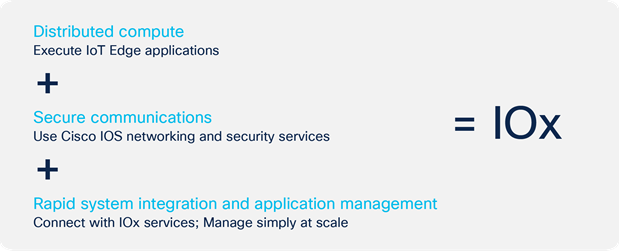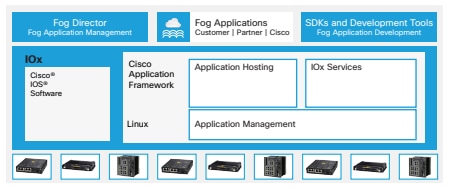Cisco IOx and Edge Applications At-a-Glance
Available Languages
Bias-Free Language
The documentation set for this product strives to use bias-free language. For the purposes of this documentation set, bias-free is defined as language that does not imply discrimination based on age, disability, gender, racial identity, ethnic identity, sexual orientation, socioeconomic status, and intersectionality. Exceptions may be present in the documentation due to language that is hardcoded in the user interfaces of the product software, language used based on RFP documentation, or language that is used by a referenced third-party product. Learn more about how Cisco is using Inclusive Language.
● Transformation of IoT data into new digital business value: Build new business with the ability to process high volumes of data at the IoT Edge and deliver closed loop system control in real time.
● Rapid time to value: Reach business outcomes associated with IoT initiatives more rapidly with application execution within the IoT Edge devices.
● Broad scope of impact: Reach production deployment rapidly with IoT Edge application management and execution at IoT scale.
Harness IoT Data, Deliver Insight, Drive Digital Business Forward
Businesses ranging from corporations in manufacturing and energy to public sector organizations such as cities and transportation authorities have used IoT technologies to produce high impact business outcomes, including faster product introductions, more engaging services, and increased operating efficiency.
The Cisco® IoT portfolio integrates the essential IoT elements required for customer success. IOx combines IoT application execution within the IoT Edge devices, secure connectivity with Cisco IOS® Software, and powerful services for rapid, reliable integration with IoT sensors and the cloud.

By bringing application execution capability to the source of IoT data, customers overcome challenges with high volumes of data and the need for automated, near-real-time system responsiveness. (See Figure 1.)
Accelerate Time to Value for IoT-Driven Digital Business
IoT Edge applications offer customers and ecosystem partners the ability to transform IoT sensor data and perform control functions within the distributed network infrastructure. With the support of IOx resident on routers, switches, and compute modules, the distributed IoT network functions as the compute environment for Edge applications. With the secure connectivity services and common application framework offered by IOx and Edge applications, customers have delivered business outcomes rapidly with their IoT initiatives. Examples across industry include:
● Manufacturing companies connect machines, transform sensor data, and perform real-time analytics to predict when maintenance is necessary and increase Overall Equipment Effectiveness (OEE).
● Mobile network operators manage their cell tower assets remotely. With real-time insight from IoT Edge applications, they make sure of proper operation, prevent theft, and save money.
● Utilities drive up grid reliability using IoT Edge applications to transform SCADA data into real-time insight and control.

Cisco IOx Application Environment
● Cisco IOx: Cisco IOx brings together Cisco IOS software, the industry-leading networking operating system, and Linux, the leading open-source platform. With Cisco IOx, your developers benefit from familiar processes and open-source tools prevalent with Linux while generating applications that execute on Cisco IoT network infrastructure.
● Edge Application Management: Cisco Field Network Director (FND), Kinetic-GMM and DNA-C allows administrators to manage, administer, monitor, and troubleshoot applications running in the Cisco IOx environment remotely over the network.
● SDK and development tools: Cisco IOx SDK is a collection of tools and methodology guidelines to help developers package their applications for execution on IOx-enabled network infrastructure products.
● Simple: Out-of-the box, scalable deployment with security
● Flexible: Tools for multitude of edge compute options
● Scale with partner: Ecosystems cloud/platform/app partners
Only Cisco delivers the capability to execute IoT Edge applications within the distributed network infrastructure. The Cisco IOx application framework offers consistent management and hosting across network infrastructure products, including Cisco routers, switches, and compute modules. IOx allows application developers to work in the familiar Linux application environment with their choice of languages and programming models with open-source development tools.